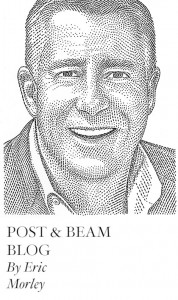A homeowner building in the Outer Banks emailed a great question this week:
“I was wondering if people typically use your trusses as structural members or just as decorative members attached to the existing frame structure?” We build and install both decorative and structural timber framing.
What Is Decorative Timber Framing?
Non-structural, or decorative timber framing, is frequently timber frame trusses in a cathedral ceiling or beams on a flat ceiling. Our engineers call this timber framing non weight-bearingin other words, the timber isn’t holding up or supporting anything above it. As an example, suppose a great Room is designed with 2×10 ceiling rafters framing and holding up the roof. If you choose to install timber frame trusses under the 2×10 rafters, the timber frame trusses wouldn’t be structural because the 2×10 rafters are actually doing the work of supporting the roof.
Over the years, we’ve built a lot of non-structural timber framing. Our yardstick for this work is simple: to look right, it must look as if it is structural.
Back to our great room example. Structural trusses usually have between 6’ and 8’ spacing between trusses. So if a great room was 16’ wide and 24’ long, we’d design three trusses for the room — one at 6’, one at 12’, and one at 18’. Sometimes, we might include two more — one at each of the gable ends (at 0’ and 24’).
Often we make these end trusses half-thickness so as to appear partially embedded in the wall. In addition to truss spacing, in order to look right, the trusses must be built using appropriate timber sizes. A structural truss spanning a 16’ wide great room would probably need to be built from timber at least 6” wide – i.e. we might use 6” x 12” timber for the rafters and lower chords.
If the truss were built from smaller material, say 4” x 6”, it wouldn’t look structural, and that’s what would make it not look right. Conversely, to look structural, there shouldn’t be too many trusses, or built from timber sizes that are oversized–that doesn’t look right either.
Our yardstick for designing and installing non-structural timber framing involves a mental picture: at some point in the future, the homeowner has a guest visit the home. This guest may be an architect, an engineer, or perhaps another timber framer. We want that guest to look up, and stand there for many minutes trying to figure out if the timber is structural or non-structural, then turn to you and ask.
Pros of Decorative Timber Framing
- A great place to use reclaimed beams. Reclaimed beams are normally not graded or grade-stamped, which is required by engineering for structural timber framing.
- They can be (and often are) retrofit from below after the roof is in place. The benefit is that the timber is protected from the weather, and since it is installed later in the process, it is unlikely to be damaged by other trades. As you might imagine, this costs a bit more than setting heavy timber from above with a crane (picture each 400 lb. timber being unloaded and carried by hand into your great room).
- Pre-finished. We frequently apply a finish to the timber because most builders agree that it’s less expensive for our crew to finish the timber framing in our shop while it’s on sawhorses than it is for a painting subcontractor to erect scaffolding and apply two coats of finish on site.
- Great for remodeling. We can add or retrofit timber framing and beams to existing houses and have done so many times as a part of a remodeling project.
Cons of Decorative Timber Framing
- Need to carefully consider spacing, timber sizes, and proportions so that it looks right (structural).
- Added weight: timber is heavy. For example, a single 6” x 12” x 16’ Douglas fir timber weighs about 4 lbs. per board foot or 384 lbs. An engineer needs to be consulted to determine that your framing is designed to safely support the added weight of non-structural timbers.
What Is Structural Timber Framing?
Structural timber framing, as you might expect, is when the timber framing is weight-bearing, or doing the work of holding up part of the house above it. If we return to the great room example, your architect and builder might decide to support the roof using structural timber frame trusses. In that case, the timber frame trusses would be designed and engineered to support the weight of the decking (usually 2×6 tongue & groove) or sheetrock ceiling, the insulation, the roofing, and the wind and snow loads.
Pros of Structural Timber Framing
- It looks right. The aesthetic concern of looking right is addressed automatically because the timber framing has been engineered to be structural.
- It replaces some structural conventional 2x framing, which can help offset the cost.
- Durability. If kept dry, timber framing can (and does) last for centuries.
- Safety. We don’t like to think about it, but houses sometimes burn. Unlike steel or 2x4s, timber framing provides more time for the family to safely get out of a home in a fire (see the FOR ARCHITECTS section on our website for an article on the subject).
Cons of Structural Timber Framing
- More expensive than conventional 2×4 framing.
- Must be engineered; however, this isn’t a major cost in most projects.
- Installed earlier in the building process — meaning it has to be planned in advance and protected during the balance of the construction process.
Learn More: Our Timber Frame Glossary
